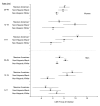Incidence of cytomegalovirus infection among the general population and pregnant women in the United States
- PMID: 17605813
- PMCID: PMC1925089
- DOI: 10.1186/1471-2334-7-71
Incidence of cytomegalovirus infection among the general population and pregnant women in the United States
Abstract
Background: Cytomegalovirus (CMV) is a common opportunistic infection among HIV-infected individuals, a major source of serious complications among organ-transplant recipients, and a leading cause of hearing loss, vision loss, and mental retardation among congenitally infected children. Women infected for the first time during pregnancy are especially likely to transmit CMV to their fetuses. More children suffer serious disabilities caused by congenital CMV than by several better-known childhood maladies such as Down syndrome or fetal alcohol syndrome
Methods: Using CMV seroprevalence data from the nationally representative Third National Health and Nutrition Examination Survey, we estimated CMV incidence among the general United States population and among pregnant women. We employed catalytic models that used age-specific CMV seroprevalences as cumulative markers of past infections in order to derive estimates of three basic parameters: the force of infection, the basic reproductive rate, and the average age of infection. Our main focus was the force of infection, an instantaneous per capita rate of acquisition of infection that approximates the incidence of infection in the seronegative population.
Results: Among the United States population ages 12-49 the force of infection was 1.6 infections per 100 susceptible persons per year (95% confidence interval: 1.2, 2.4). The associated basic reproductive rate of 1.7 indicates that, on average, an infected person transmits CMV to nearly two susceptible people. The average age of CMV infection was 28.6 years. Force of infection was significantly higher among non-Hispanic Blacks (5.7) and Mexican Americans (5.1) than among non-Hispanic Whites (1.4). Force of infection was significantly higher in the low household income group (3.5) than in the middle (2.1) and upper (1.5) household income groups. Based on these CMV incidence estimates, approximately 27,000 new CMV infections occur among seronegative pregnant women in the United States each year.
Conclusion: These thousands of CMV infections in pregnant women, along with the sharp racial/ethnic disparities in CMV incidence, are compelling reasons for accelerating research on vaccines and other interventions for preventing congenital CMV disease. Nevertheless, the relatively low force of infection provides encouraging evidence that modestly effective vaccines and rates of vaccination could significantly reduce CMV transmission.
Figures



References
-
- Alford CA, Stagno S, Pass RF, Britt WJ. Congenital and perinatal cytomegalovirus infections. Rev Infect Dis. 1990;12 Suppl 7:S745–S753. - PubMed
-
- Stagno S. Cytomegalovirus. In: Remington JS and Klein JO, editor. Infectious diseases of the fetus and newborn infant. Philadelphia, W.B. Saunders Company; 2001. pp. 389–424.
-
- Pass RF, Hutto C, Ricks R, Cloud GA. Increased rate of cytomegalovirus infection among parents of children attending day-care centers. N Engl J Med. 1986;314:1414–1418. - PubMed
Publication types
MeSH terms
LinkOut - more resources
Full Text Sources
Medical
Miscellaneous

